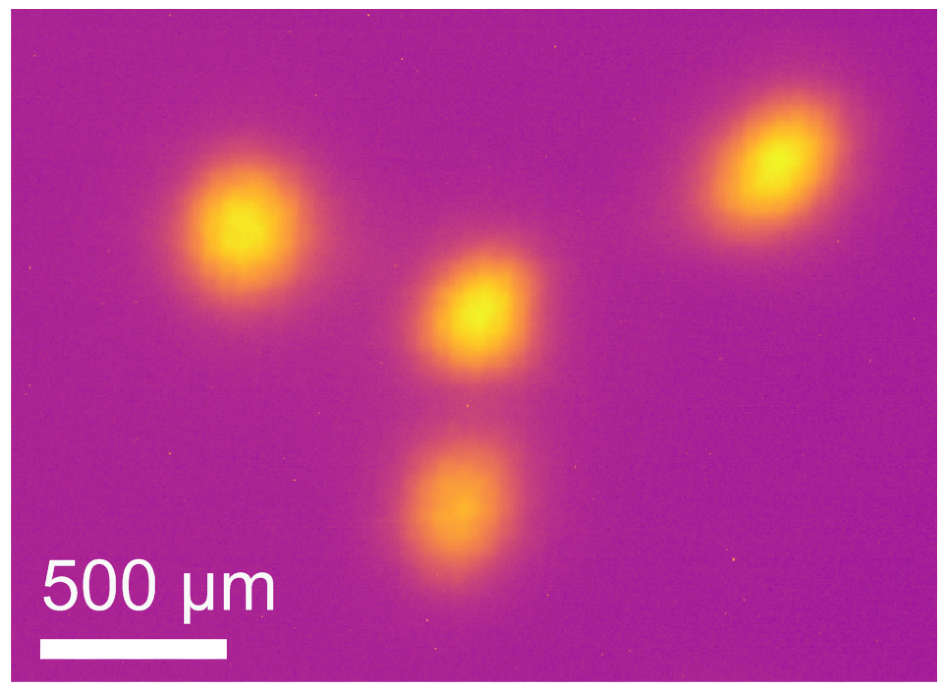Apr 2 2020
A collaborative team of accelerator physicists, experimenters, and undulator experts at the BESSY II storage ring has demonstrated a new method to rapidly switch the helicity of circularly polarized synchrotron radiation—up to a million times more rapidly than before.
 This picture shows an X-ray image of the electron beam in TRIB-mode where two orbits co-exist: the regular orbit and the second one winding around it closing only after three revolutions. Image Credit: © F. Armborst/K. Holldack.
This picture shows an X-ray image of the electron beam in TRIB-mode where two orbits co-exist: the regular orbit and the second one winding around it closing only after three revolutions. Image Credit: © F. Armborst/K. Holldack.
Using an elliptical double-undulator created at Helmholtz-Zentrum Berlin (HZB), the team operated the storage ring in what is known as a two-orbit mode. This mode of operation is unique and was recently designed at BESSY II. It offers the basis for rapid switching.
The extremely rapid change of light helicity is specifically fascinating to observe, and processes in magnetic materials have traditionally been predicted by a vast user community.
In BESSY II and other similar synchrotron radiation sources, bunches of electrons revolve around the storage ring approximately to the speed of light. These electrons are forced to produce very bright light pulses with unique properties by periodic magnetic structures, or undulators.
Experiments with Polarized Light Pulses
Circularly polarized light pulses can also be generated using elliptical undulators. These light pulses exhibit a property known as helicity: the polarization travels in either clockwise or counterclockwise direction. In materials, magnetic structures respond in a different way to circularly polarized light: they absorb this radiation to a certain extent based on the helicity of the X-ray pulses.
Since the 1980s, this has been manipulated in the so-called X-ray Circular Dichroism (XMCD) experiments to capture the pictures of magnetic nanostructures on surfaces, or to analyze both dynamic and static variations in magnetic materials.
Mapping Dynamics in Magnetic Materials
Particularly for such imaging methods, the user community at synchrotron radiation sources has been looking forward to rapidly change the light’s helicity, primarily because this immediately leads to a magnetic image contrast that renders the bits in magnetic data storage devices both visible and computable.
The helicity of light in the elliptical undulators typical for APPLE II (BESSY II)—created by the team around Johannes Bahrdt)—is changed by mechanical displacement of meter-long arrangements of robust permanent magnets, a process that, at times, involves several minutes.
Two Orbits
But the latest technique is based on the combination of these undulators with a unique orbit of the electron beam in the storage ring. This storage ring is produced by the so-called transverse resonance island buckets (TRIBs). Dr Paul Goslawski, an accelerator expert at BESSY II, has experimentally analyzed TRIBs.
While the course of the electrons present in the storage ring usually closes following a single orbit, the electrons in the TRIBs mode run on varying orbits during consecutive orbits and can, therefore, discharge X-ray pulses from different configurations of the magnetic field, indicated Dr Karsten Holldack and Dr Johannes Bahrdt.
And it Works
The duo recently demonstrated that their concept works with the aid of a present-day double undulator called UE56-2, used at BESSY II in a pilot study:
When traveling via a uniquely prepared magnet arrangement of the UE56-2 double undulator, the bunch of electrons from different orbits in TRIBs mode released X-ray photons that had the same wavelength but revere circular polarization.
Switching a Million Times per Second
Hence, theoretically, XMCD signals emitted by magnetic samples can currently be analyzed at intervals of just 1 µs with a right-circularly polarized light pulse and then left-circularly polarized light pulse.
In the pilot study, the XMCD signals emitted by a magnetic sample (nickel in permalloy) were identified from one revolution to the other and the rapid (MHz) change in helicity could particularly be established.
With the latest undulators customized for this purpose, unique beamlines with extremely fast helicity change could be provided at BESSY II in TRIBs mode. In the end, switching times could be reduced to nanoseconds.
Outlook: BESSY III
We are really delighted that the Two-Orbit / TRIBs development allows now already new experiments at BESSY II.
Paul Goslawski, Accelerator Expert, BESSY II, HZB
This may even offer an attractive option for BESSY III. The study results have currently been published in the Nature Communications Physics journal.